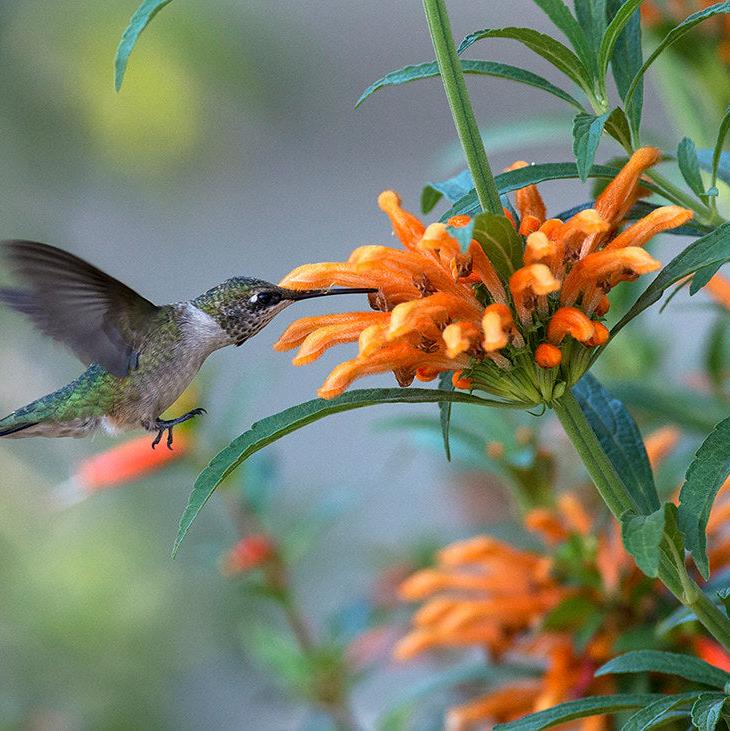VIRIAR
Leonotis leonurus - Lion's tail - 40 pieces fresh seeds
Leonotis leonurus - Lion's tail - 40 pieces fresh seeds
Impossible de charger la disponibilité du service de retrait
Plant Description
Name: Leonotis leonurus
Common Names: Lion's Ear, Wild Dagga, Lion's Tail
Leonotis leonurus, commonly known as Lion's Ear, Wild Dagga, or Lion's Tail, is a perennial shrub native to South Africa. This plant is notable for its tall, upright growth habit and striking tubular flowers, which are typically a bright orange but can also be white in some cultivars. The flowers are arranged in whorls around the upper stems, creating a spectacular visual display that resembles a lion's tail, hence its common name. The plant's leaves are aromatic, lance-shaped, and dark green, adding to its ornamental appeal.
Lion's Ear grows to a height of 1.5 to 2.5 meters (5 to 8 feet) and spreads about 1 to 1.5 meters (3 to 5 feet) wide. It is a fast-growing plant that thrives in sunny locations and is often used in borders, as a background plant, or in wildlife gardens due to its attraction to hummingbirds, bees, and butterflies. In addition to its ornamental value, Leonotis leonurus has been used in traditional medicine for its anti-inflammatory and analgesic properties.
Cultivation of Leonotis leonurus
Conditions:
- Light: Leonotis leonurus thrives in full sun, requiring at least 6 to 8 hours of direct sunlight per day to produce the most vibrant flowers and maintain its upright growth habit. It can tolerate partial shade but may result in fewer blooms and leggy growth.
- Temperature: This plant is suitable for USDA hardiness zones 8-11. It prefers warm climates and is frost-sensitive, so it should be protected or grown as an annual in colder regions. In areas with mild winters, it remains evergreen; otherwise, it may die back to the ground and resprout in spring.
- Soil: Lion's Ear prefers well-drained, sandy, or loamy soils with a neutral to slightly acidic pH. It can tolerate poor soils, including rocky and sandy conditions, but does not do well in heavy clay soils that retain water.
- Water: Leonotis leonurus is drought-tolerant once established, but it benefits from regular watering, especially during prolonged dry periods. Water deeply but infrequently, allowing the soil to dry out between waterings. Overwatering should be avoided to prevent root rot.
Planting and Care:
- Planting: Plant Leonotis leonurus in the spring after the danger of frost has passed. Choose a sunny location with well-drained soil. Dig a hole twice the width of the root ball but no deeper. Place the plant in the hole, backfill with soil, and water thoroughly to settle the roots.
- Fertilization: Fertilize in early spring with a balanced, slow-release fertilizer to promote healthy growth and flowering. Too much nitrogen can result in lush foliage at the expense of flowers. A monthly application of compost or organic fertilizer during the growing season can also be beneficial.
- Pruning: Prune lightly in late winter or early spring to remove dead or damaged stems and encourage bushier growth. Cutting back the plant by one-third after flowering can help maintain its shape and promote a second bloom cycle in warmer climates.
Propagation
- Seeds: Leonotis leonurus can be propagated from seeds sown in spring. Sow seeds in well-draining soil, covering lightly, and keep moist until germination, which typically takes 2-4 weeks. Transplant seedlings when they are large enough to handle.
- Cuttings: Propagation by softwood cuttings is also effective. Take cuttings from new growth in late spring or early summer, dip the cut ends in rooting hormone, and plant them in a sandy or perlite-based potting mix. Keep the cuttings moist and in a warm, bright location until roots develop.
Shipping & Returns
Shipping & Returns












